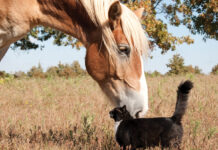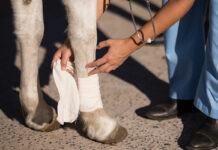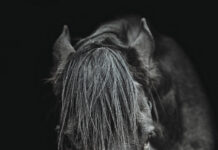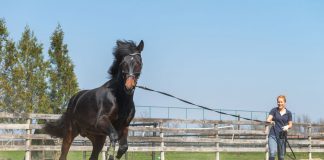
The woman on the phone was someone I didn’t know. “Hello Dr. Diehl. I was wondering if you could come see my horse sometime this week. He has a little skin problem and we have some important shows coming up.”
Ugh. I really didn’t want to deal with the place, but the lady and her horse needed help. She’d sounded very nice on the phone, so I was hopeful.
Baldor is Balding
I pulled up, parked, and was immediately asked to move my truck by the barn manager. I parked somewhere else, and promptly got a complaint from a woman in an SUV. I’d apparently parked in “her” spot, so I moved the truck a third time. Finally I entered the barn. A gaggle of boarders were in a tight huddle gossiping, but quieted as I passed.
The owner was waiting with her horse, a large Friesian. He was a sorry sight, with large bald patches all over his body. His face, neck, back and torso were mainly affected, but there were also bald spots on his legs.
“Hello Dr. Diehl, and thank you for coming. This is Baldor, my beautiful boy. His name means Lord or Prince.” There wasn’t a trace of irony in her words.
With effort, I kept a serious expression as I took down the horse’s history. He was 5 years old with no previous history of skin problems. The condition had started about seven weeks ago. Per the recommendations of the barn manager and her trainer, she’d slathered various shampoos and washes over the horse’s body.
I slipped on a pair of gloves and examined the gentle horse, giving him a head rub as I moved around him. The exposed skin was crusty and oozing and scaling with shallow erosions evident, and I was able to easily pull a huge clump of black hair free. The ends of the hair shafts were stuck together by a layer of tissue. His coat was simply sloughing off.
Rain Rot or Not
I was staring at a mass of hair in my hand when a voice interrupted and I turned to see the barn manager glowering at the owner. Although I’d been a presence at this barn for years, she always pretended not to know me.
The owner looked guilty. “It’s just that nothing is helping Baldor, and I really felt it was time to get him checked.”
The manager plunked a bottle of shampoo down onto the ground. “Well, it’s your horse,” she said unnecessarily. Then she faced me. “I already know what it is. It’s obviously rain rot.”
Rain rot is a skin disease typically seen in damp, warm climates. We were high in the Rocky Mountains and had just enjoyed a month straight of sun and blue skies, plus the pattern of lesions didn’t fit, but I didn’t feel the need to argue. I smiled at her, turned back to the horse and continued my exam.
Somewhere in a dim recess of my brain, I felt that I’d seen something like this before. I tuned out the barn manager, who was giving a loud and mostly incorrect lecture about rain rot, and focused my thoughts. Then I had it, an autoimmune skin disorder called pemphigus … something. Ah, pemphigus foliaceus, a disease in which the immune system created antibodies against its own skin, destroying the bonds that hold the skin cells together.
I’d never seen a case in a horse before, only in a dog. But in my mind’s eye, I could almost see the paragraph from my dermatology textbook, and this horse had all of the symptoms. I just needed a biopsy to confirm the diagnosis.
The owner gave permission for the biopsy, much to the dismay of the barn manager. The pathologists confirmed the disease, and I put Baldor on oral steroids, vitamin E, and a good fatty acid source.
Help is a Click Away
When I arrived several days later to recheck him, the barn manager was waving some sort of clicking wand at the horse and scowled at me as I took the horse’s vitals. It was too soon to tell if the treatment was helping, but I wanted to make sure that he wasn’t having a negative reaction to the steroids.
A small audience of boarders watched the magical clicking wand in awe, several taking videos with their phones. When the crowd cleared, I checked Baldor’s vitals with my boring stethoscope and thermometer, and made sure his feet weren’t sore with my boring hoof testers. He was doing just fine.
Ten days later, Baldor was improving. At the four-week mark, we could see his new coat starting to fill in, and by 10 weeks, it was hard to tell that he’d ever had a skin problem.
As I was rechecking Baldor one afternoon, and came face to face with the barn manager. I was surprised by her friendly greeting. Clearly my great success with Baldor had raised my status, and I tried not to feel smug as I waited for her next admiring words.
She smiled sweetly. “I just wanted to let you know that after my success in treating Baldor, I’m now a rep for the Clicking Wand Company, and I thought you might want to buy one.”
Courtney S. Diehl, DVM, has been an equine veterinarian since 2000. She resides in Steamboat Springs, Colo., where she is in private practice. Her first book, Horse Vet, Chronicles of a Mobile Veterinarian, was published in 2014, and she is currently at work on her second book.
Liked this article? Read past Vet Adventures columns:
A Watched Mare Never Foals
Repro Woes
The Remedy
This article originally appeared in the July 2016 issue of Horse Illustrated magazine. Click here to subscribe!






